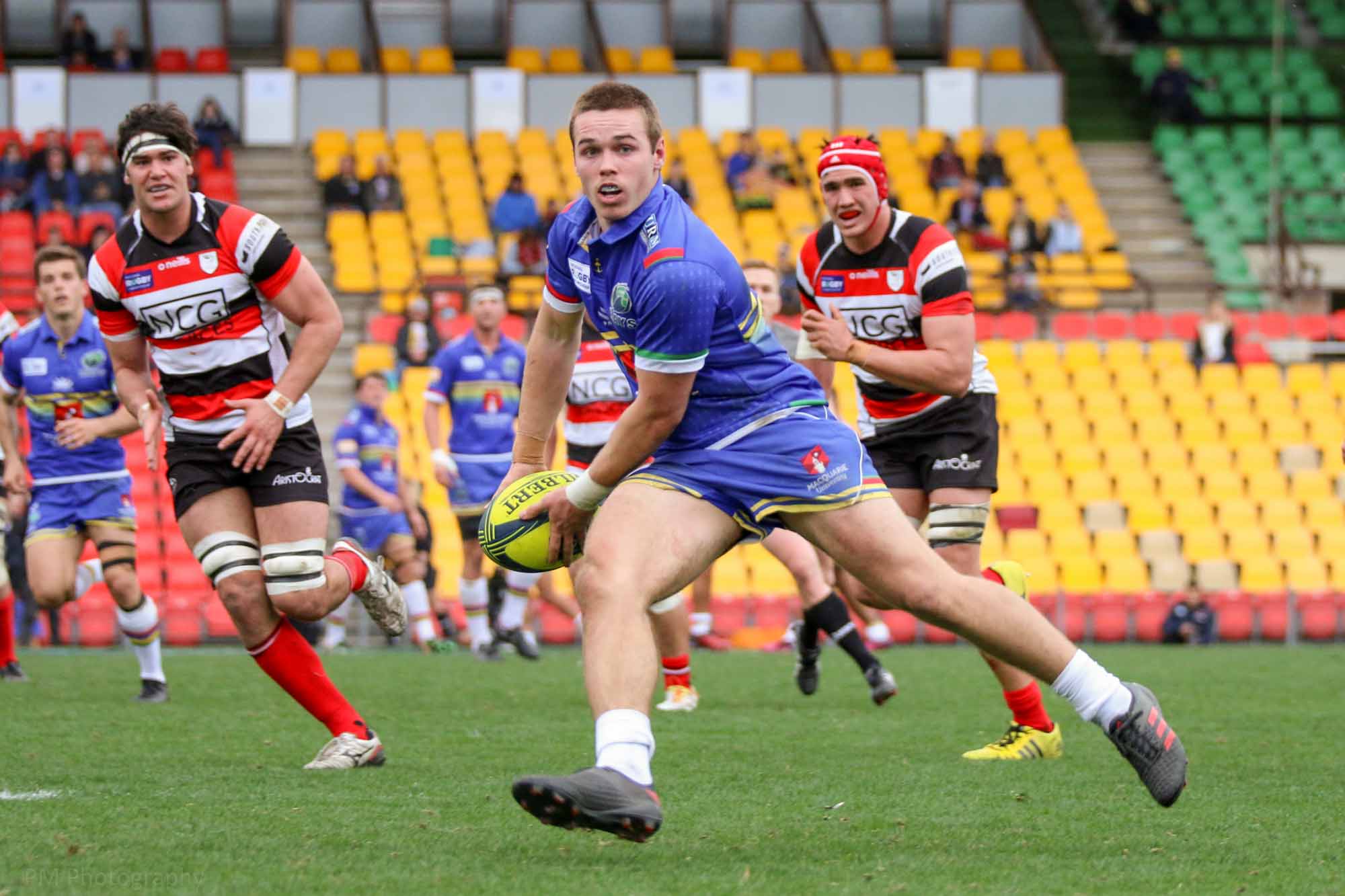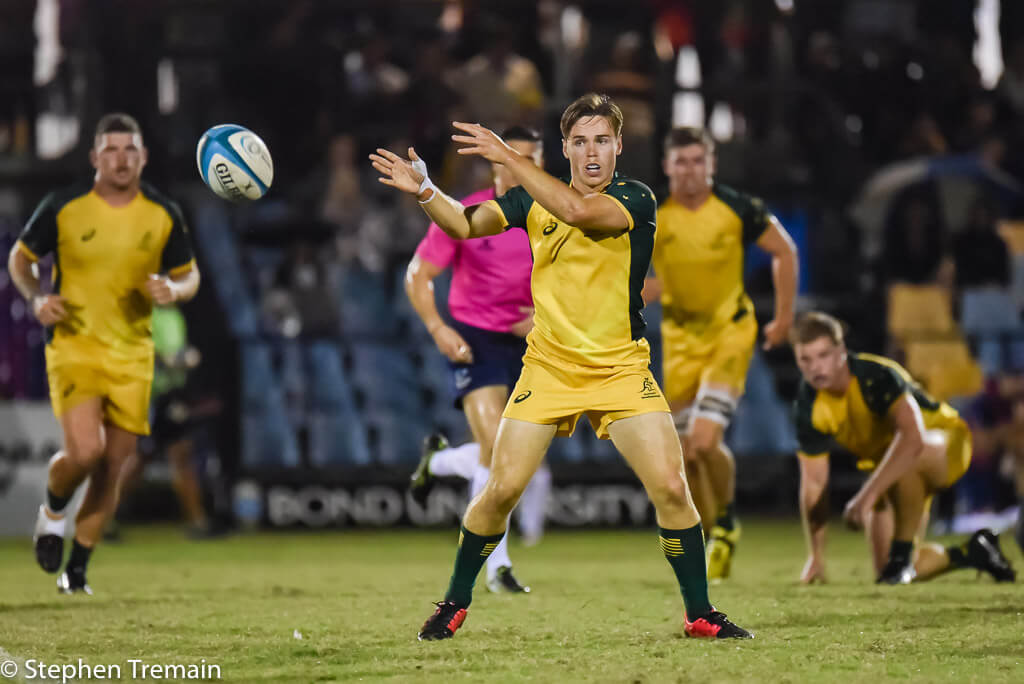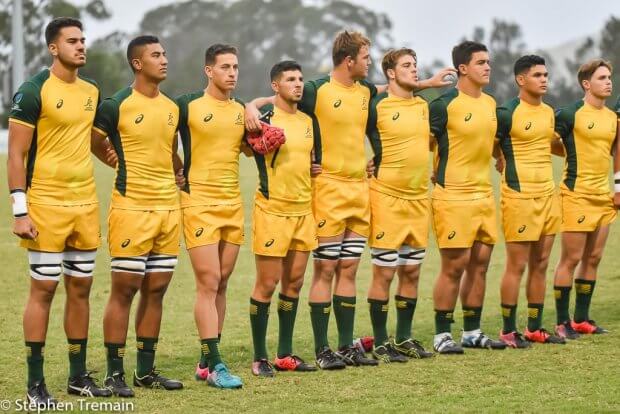The current frontrunners for the Wallaby flyhalf jersey will be 29 (Matt Toomua), 30 (Bernard Foley and Kurtley Beale), 31 (Quade Cooper), or 32 (Christian Lealiifano) years old by the time the Rugby World Cup rolls around in September. It’s very unlikely that any of these players will still be around in 2023 for the next World Cup, and it would be a damning sign if they were –most of these players were already becoming professional during the 3 World Cups ago!
These aren’t the only options, however. Clearly, the selectors prefer them (and the cover potentially provided by versatile 24-year-old Reece Hodge) to any of the others in Super Rugby such as Bryce Hegarty and Matt McGahan, but actually getting Super Rugby game time is not a requirement for selection. No, I’m not talking about Mack Mason again, but rather his teenage understudy. The understudy to the understudy.

Will Harrison has been showcasing his wares in Argentina this week as part of the World Rugby U20 Championship, and there is a growing sentiment that he may be the best number 10 in the world in the age-bracketed version of the game. The teenage sensation has not come from nowhere, having captained the Australian Schoolboys in 2017 immediately after returning from an injury-enforced break. This is all the more impressive when taking into account that Harrison’s school doesn’t even have a rugby team!
In fact, Harrison’s only opportunity to experience the game they play in heaven came through teenage club rugby, playing for the Clovelly Eagles near Randwick. Though he has been able to fill in the 12 and 15 jerseys at a pinch, he has taken a firm grasp of the steering wheel since joining the Junior Wallabies. His most notable accomplishment in this role was defeating the New Zealand U20s last month, but in less than two weeks he may have another feather to add to his cap.
Looking at this historic game, in which the Baby Blacks were kept scoreless despite having won the Oceanic tournament 4 out of 4 times and the international tournament 6 out of 11 times, the first thing that is apparent is his ability to kick for goal. The first half of this game is devoid of tries, but Harrison keeps the scoreboard pressure mounting on the Kiwis by slotting 4 from 4 attempts – often at long range.
Something that only becomes apparent on closer observation is Harrison’s willingness to get into the thick of things. This is unusual for the position, especially considering Harrison’s relatively small 177cm height and 84kg weight. He plays a significant part in Australia’s first minute try, chasing his own kick the length of the field and tackling its recipient. He doesn’t stop here, however. In fact, Harrison manages to charge down the clearing kick and then regather it. In the space of a few seconds, Harrison has gained the Junior Wallabies 90 metres of territory while retaining possession. This leads directly to a try only seconds later.
Similar moments of game-changing excellences can be found in recent games against Italy and U20 6 Nations champions Ireland. In the below video from the game against Italy, Harrison creates a brilliant try out of nothing for Lachlan Lonergan, scything through the post-lineout defensive line with Beauden Barrett-like ease.
Speaking of Beauden Barrett, Harrison channels the twice World Player of the Year in the subsequent game against Ireland and uses his speed and offloading ability to exploit a half-gap and put his winger away in the corner.
Harrison is eventually rewarded with a try of his own, running a support line and breaking a tackle before winning the 40-metre race to the line.
Harrison clearly has a lot to offer on attack. The concern, as with many U20 and schoolboy players, is that he won’t be able to measure up to the physicality of the sport once the age restrictions are lifted. There is no guarantee for this, but in my view it is time that Australia took a look at the way the modern game is being played before casting aside Harrison for being too small. Richie Mounga and Damian McKenzie are within 1” and 2kg on either side of Harrison, and the best team in the world has obviously determined that the speed and agility they offer is worth the trade-off in terms of size.
Importantly, these two players are often utilised by the All Blacks as bench impact players. Wallabies coach Michael Cheika has also shown a willingness to run a playmaker on the bench, testing Foley and Toomua there in 2018 and Cooper in 2017. These players are comparatively too old and slow to be seriously considered as impact players, but Harrison is faster and more agile than many wingers and could easily break open a game against tired forwards. The possibility of a Kiwi coach taking the reins in 2020 may also mean that smaller players, like Harrison, will get a better shot at international selection.
As well as being able to be used to break open the last quarter of the game, Harrison simply looks more like a modern flyhalf than any of the candidates the Wallabies have at the moment. This is unsurprising considering their age, but defenses in 2019 are too well-drilled for flyhalves to be a mere link in the chain. Nowadays, they need to present a genuine threat to the line in order to hold defenders in place and create opportunities for the players outside them. Harrison’s athleticism creates this risk for the opposing team. He has also been combining wonderfully with Isaac Lucas at fullback, and with many modern teams running the second playmaker at 15 rather than 12 this could be a partnership that works for the more senior Wallabies further down the track.
Additionally, Harrison has a world-class success rate kicking from the tee. From the 3 games mentioned, Harrison kicked 17 from 21 shots despite a number of them being quite difficult. Given Foley’s tendency to miss potentially match-winning kicks, bringing on a more consistent kicker at the right moment could be the difference.

In answer to the article’s headline, it is obviously too soon for Harrison to helm the Wallabies only 3 months from now. As stated earlier, there is no guarantee with any young player that their skills will transfer to the adult game. Conversely, Cheika will probably trial a good number of players in the Rugby Championship, and more still may be included in an extended training squad. In 2015, Cheika named 40 players for the Rugby Championship and if some of these players are injured or struggle with the intensity of test rugby, then this number could be increased. Considering the current flyhalf selection dilemma, Harrison’s name might just find its way into the long list of names at the fringes of selection.
If this still sounds too far-fetched, go back to the start of the article where I pointed out that Harrison’s school didn’t have a rugby team. This is the same school that Cheika attended, and Harrison also plays for the same club as the national coach. In fact, Harrison’s father (Mark) actually played alongside Cheika at Randwick. Cheika has attended a number of Schoolboy games that Harrison was captain for, so there is no doubt that the Wallabies coach is at well-aware of the young flyhalf.
The final factor that may play into these calculations is Harrison’s left-footed kicking ability. If you watch the full games on Kayo, you will see Harrison punishing his opponents for ill-discipline by chewing off huge chunks of territory with his left boot. Very few players in Wallaby contention have this capability at the world-class level. Cheika recognises it as a necessity, having notably changed the eligibility rules in 2015 to get left-footed kickers Drew Mitchell and Matt Giteau into the squad.
I have written a similar article about 20-year-old Tate McDermott previously. Imagine the damage a bench containing these two exciting young blokes and Reece Hodge could do coming off the bench in the last 20 minutes against exhausted players twice their size. While Joe Powell is still the more likely scrumhalf replacement and there are already a number of flyhalves in the squad, all it takes is one injury, poor performance, or interpersonal spat with the coach for an opportunity to arise. A number of other U20 players have stood out including Isaac Lucas, Nick Frost, Fraser McReight, and Angus Bell, but none are standing out in positions the Wallabies are in such dire need of filling.
The Junior Wallabies are likely to face the Baby Blacks again in the finals of the U20 Championship. If they can keep the New Zealanders from getting their revenge for last month’s humiliation on the Gold Coast, and if the Rebels are unable to topple the Chiefs and secure a second Australian team’s place in the Super Rugby finals for the first time since 2015, then who can blame Cheika if he chooses to give a bolter a chance?
Author’s note: this article was written before round 3 of the U20 Championship early this morning


